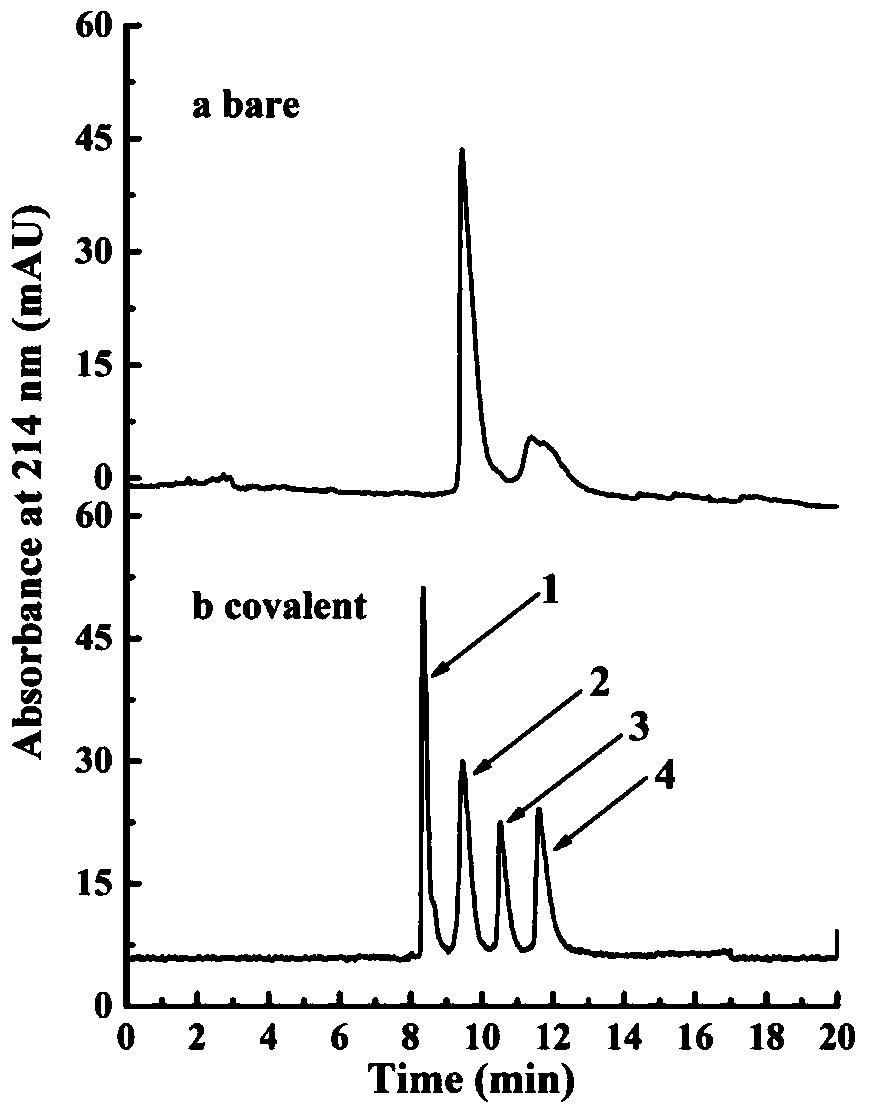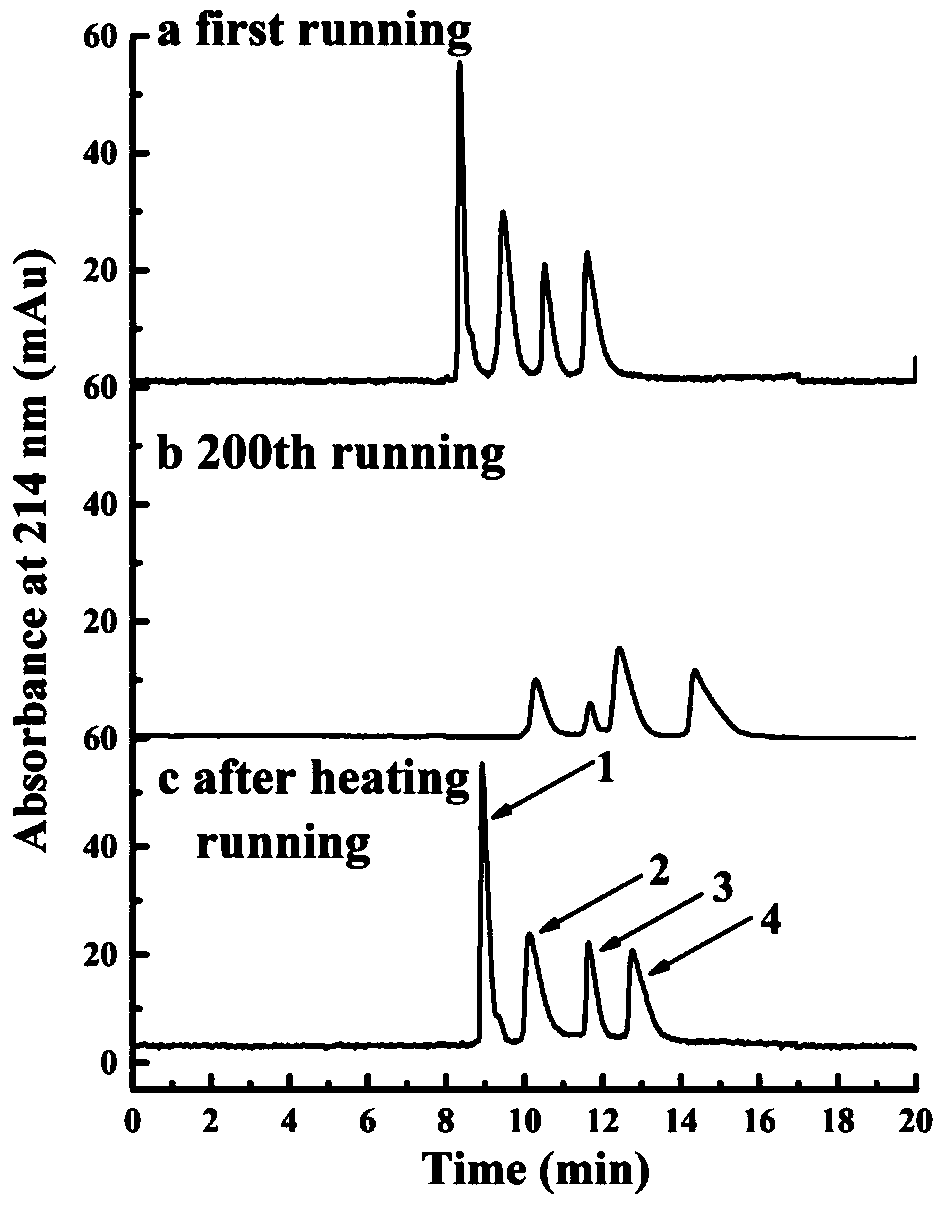A temperature-sensitive regenerable capillary, its preparation method and application
A temperature-sensitive, capillary technology, applied in the direction of instruments, measuring devices, scientific instruments, etc., can solve the problems of complex coating process and difficult regeneration of capillary wall coating materials, and achieve weak anti-protein adsorption ability and anti-protein adsorption ability strong effect
- Summary
- Abstract
- Description
- Claims
- Application Information
AI Technical Summary
Problems solved by technology
Method used
Image
Examples
preparation example Construction
[0037] The preparation method of the above-mentioned temperature-sensitive regenerative capillary is as follows: image 3 shown, including the following steps:
[0038] S0, capillary internal activation pretreatment
[0039] Concentrations of 0.09-0.11mol·L were used successively -1 Sodium hydroxide solution, water, the concentration is 0.09-0.11mol L -1 Flush the capillary with hydrochloric acid solution, water and methanol for 25-35min, 8-12min, 25-35min, 8-12min and 8-12min respectively, and then dry the capillary with inert gas to obtain an activated capillary.
[0040] S1, the concentration is 2.0mg·ml -1 -4.0mg·ml -1 The photosensitive diazo resin solution, the temperature-sensitive polyethylene glycol solution and water with a concentration of 4.0mg·ml-1-8.0mg·ml-1 are slowly injected into the capillary, and repeated 2-8 times; the photosensitive diazo The mass ratio of the resin to the temperature-sensitive polyethylene glycol is 1:1-1:2, the weight-average molecu...
Embodiment 1
[0051] A temperature-sensitive regenerable capillary, the inner wall of the capillary is modified with a regenerable anti-protein adsorption covalently bonded coating formed by a temperature-sensitive high molecular polymer material, and the regenerable anti-protein adsorption covalently bonded coating It is in a stretched or contracted state as the temperature changes, so that the pore size of the capillary changes with the temperature change. The temperature-sensitive polymer material layer is a regenerative anti-protein adsorption covalently bonded coating formed by diazo resin and temperature-sensitive polyethylene glycol. When the temperature is lower than the formed regenerative anti-protein adsorption covalently When the temperature is lower than the lower critical solution temperature of the valence bonded coating, the polymer material layer is in a stretched state; when the temperature is higher than the lower critical solution temperature of the formed regenerative an...
Embodiment 2
[0063] The structure of the temperature-sensitive regenerable capillary of this embodiment is the same as that of the embodiment, and its preparation method includes the following steps:
[0064] S0, capillary internal activation pretreatment
[0065] successively with a concentration of 0.09mol·L -1 Sodium hydroxide solution, distilled water, the concentration is 0.11mol L -1 Flush the capillary with hydrochloric acid solution, distilled water and methanol for 35min, 8min, 35min, 8min and 8min respectively, and then use N 2 The activated capillary can be obtained by drying the capillary.
[0066] S1, the concentration is 3.0mg·ml -1 8ml of photosensitive diazo resin solution, 2ml of distilled water, the concentration is 4.0mg·ml -1 8ml of temperature-sensitive polyethylene glycol solution and 2ml of distilled water are slowly injected into the capillary successively, thus completing an electrostatic self-assembly cycle; the mass ratio of the photosensitive diazo resin to ...
PUM
 Login to View More
Login to View More Abstract
Description
Claims
Application Information
 Login to View More
Login to View More - R&D
- Intellectual Property
- Life Sciences
- Materials
- Tech Scout
- Unparalleled Data Quality
- Higher Quality Content
- 60% Fewer Hallucinations
Browse by: Latest US Patents, China's latest patents, Technical Efficacy Thesaurus, Application Domain, Technology Topic, Popular Technical Reports.
© 2025 PatSnap. All rights reserved.Legal|Privacy policy|Modern Slavery Act Transparency Statement|Sitemap|About US| Contact US: help@patsnap.com



